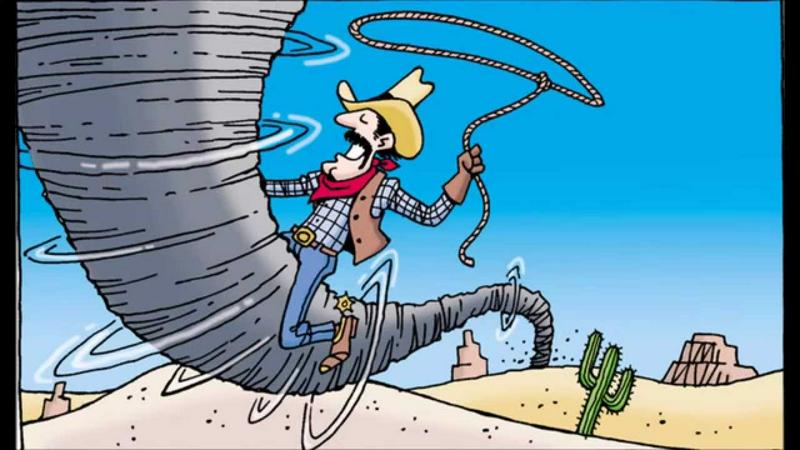The Tall Tales Of Pecos Bill
By | November 22, 2019

While heroes of folklore such as John Henry and Paul Bunyan are believed to have been inspired by real people, Pecos Bill has no such historical archetype. While there is some conflict regarding his true origin, Pecos Bill’s role as the personification of the frontier spirit seems to have been born out of the imaginations of the cowboys themselves.
According to the legends, Pecos Bill was born in Texas during the 1830s and was the youngest of eighteen children. Even as a baby, he was not normal, using a bowie knife as a teething ring. As a toddler, he was known to play with wild animals. He was still very young when he fell out of his parents’ wagon as they were crossing the Pecos River. Despite their best efforts, the family was unable to find him as he had been swept downstream by the strong currents. He survived, however, having been rescued and raised by coyotes.

Eventually, one of Bill’s brothers found him and brought him back to civilization but had to convince him that he wasn’t a coyote himself. Bill quickly adapted to the ways of the human world and became the ultimate cowboy, inventing both the branding iron and the lasso. However, in some tales, he also worked on the railroad, on an oilfield, and hunted buffalo. But it was his superhuman feats, such as riding a tornado, for which he was most famous. Sometimes he rode a mountain lion, but he could most often be seen atop his favorite horse, the dynamite-eating Widow-Maker, who earned his name due to the fact that no man alive could ride him. No man except Pecos Bill, that is.

At one point, Pecos Bill falls in love with Slue-Foot Sue, who rode a catfish as large as a whale down the Rio Grande. Bill attempts to impress Sue by shooting all but one star from the sky. That star became known as the Lone Star of Texas. They get engaged but Widow-Maker becomes jealous and, when Sue insists on trying to ride him, he bucks her off and she bounces so high she hits her head on the moon. In some versions of the tale, she never stops bouncing, but other versions have Bill lassoing her to get her down. Pecos Bill’s story comes to an end after he meets a city slicker from Boston who attempts to dress like a cowboy in lizard skin boots, brand-new jeans, a shiny belt buckle, and a dust-free ten-gallon hat. Apparently, just the sight of the man causes Pecos Bill to laugh himself to death.

While these tales are obviously fiction, there does seem to be some conflict over how they came to be. According to Edward O’Reilly, who was the first to write about the adventures of Pecos Bill in 1916 for The Century Magazine, the legend was based on campfire tales told by cowboys of the Old West. The stories became more exaggerated as time went on, resulting in the absurd situations mentioned above. O’Reilly later published his collection of tales in a book entitled Saga of Pecos Bill (1923). While O’Reilly’s claim seems plausible - after all, Pecos Bill is not so different from heroes of Greek and Roman mythology like Hercules and Beowulf which began as an oral tradition, not everyone was willing to accept it. In 1950, an American folklorist named Richard Dorson disputed O’Reilly’s claim, stating that no such folklore existed and that O’Reilly himself had made up the tales in what Dorson labeled as “fakelore.”

Regardless of its true origin, the story of Pecos Bill now resides among the folklore of the American West and has been written about by multiple authors, including James Cloyd Bowman whose novel, The Greatest Cowboy of All Time (1937), won the Newberry Award for children’s literature in 1938. There was also a comic strip about Pecos Bill resulting from a collaboration between O’Reilly and cartoonist Jack “Alonzo Vincent” Warren which ran from 1929-38. After O’Reilly’s death in 1938, Warren continued the stories in a new strip called Pecos Pete, which featured an amnesiac Pecos Bill going by a new name. Eventually, Pecos Bill made his way into the Disney universe, first in the animated shorts, Melody Time, in 1948, and later in a live-action film call Tall Tales (1995), which put him alongside Paul Bunyan and John Henry.

